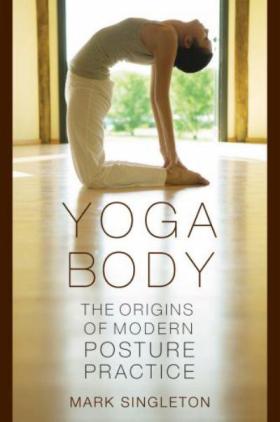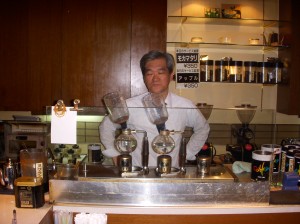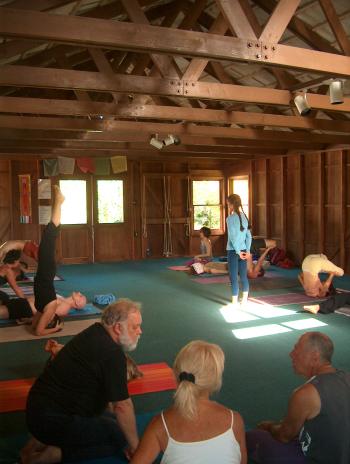Yoga Body was first introduced to me last summer by one of my philosophy teachers, Carlos Pomeda. He suggested Mark Singleton had some interesting things to say on the development of the physical yoga practice ( asana) as we see it today. For many us we seem to think that yoga has been around forever (what was it on the Lululemon bag- 7000 years??) but really asana, as we know it, is a modern invention. So modern in fact, as Mark brings up in his book- it really is a hybrid of European gymnastics, body building, and military calisthenics interpreted through the lens of an Indian people who were trying to assert their own cultural significance during an occupation by another country.
The beginning of the book is very dry- I believe the author wrote this as his PHD thesis and it is very scholarly in format and sets up his, slightly controversial, argument in the beginning chapters. If you can slog through this foundation he sets up then the last half of the book is well worth it. For those of you without that fortitude, you can start at Chapter 3 and still not lose too much of the background.
The book is divided into chapters that take us from the roots of colonialism in India and the cultural bias to the often bizarre practices of the yogins, through India’s growing wonderment and participation with the international physical culture movement. The growth of the body building movement and harmonial gymnastics weaves it’s way from Europe and North America to become influential in the asana development. ( Just a note here that Bikram’s teacher came out of this particular body building lineage in India). The section on the proliferation of the physical movement through the medium of photographs further brings to light how books, like Light on Yoga by B.K.S. Iyengar, literally became , in my words, our yoga bibles. The final chapter focuses mainly on T. Krishnamacharya and the Mysore Asana revival- very familiar to many that practice yoga in North America and Europe today.
I offer up that for many yogi’s this book may just be downright disturbing. Towards the end of the book he follows the Krishnamacharya lineage and rather than focusing on all of the descendants of that lineage ( Pattabhi Jois, Indra Devi, Iyengar, Desikachar etc) he turns his attention more to Pattabhi Jois and the power yoga and Vinyasa yoga cultures that came out of that particular practice. I have heard, and participated in, many discussions of the Vinyasa method vs the long holds of the Iyengar method. Mark Singleton brings up a very interesting hypothesis about the speed of Ashtanga yoga as taught by Pattabhi Jois. He discusses that the practice in the shala was much slower and postures held much longer than the Ashtanga method that was developed by Pattabhi Jois. He also goes as far as to postulate that the yoga demonstrations held all over south India under the auspices of the Maharaja ( Krishnamacharya’s sponsor) showcasing the talent of the shala, of which Pattabhi was a key member, were the reason there is a discrepancy between what students recall being taught in the shala versus what became known as Ashtanga Vinyasa yoga.
“The need for a coordinated, high-speed showcase might also explain why, in Jois’s system, postures are usually held only for five ( but up to a maximum of eight) audible “ujjayi” breaths: this would not only allow the models to perfectly synchronize their entry and exit from the pose but would also provide enough time for Krishnamacharya to explain the significance of a posture without taxing the attention of the audience.” ( Singleton, Yoga Body p.195)
While I found this an intriguing argument, I feel that we as the reader are left out of balance slightly because there is no real discussion of the other students that came out of that lineage and who also had significant impact on how we practice yoga today such as B.K.S Iyengar and T.K.V.Desikachar. Why is Iyengar’s yoga different than Ashtanga? Is Iyengar’s yoga more true to the actual method in the shala at that time? These questions are left unanswered and I feel unsatisfied that equal time and insight were not given to these other students of Krishnamacharya.
The photographs in the book are a marvelous way for the author to back up his arguments- you can see direct correspondence between the European practices at the time and what we now know as yoga postures. I have to admit part of me was a little disappointed to have the mythology ripped away so to speak, but if “yoga” to you means more than the postures on the mat there is a long history to back up the practices of meditation, pranayama and mantra.
Mark’s closing reflections gives us back in some ways, the real power of the posture practice: that physicality can become spiritualized and that spirituality can come into the physical practice. His remarks bring me back to my own yoga practice, which is Anusara yoga, and that Anusara practice always begins with Attitude. If your attitude is that this is a spiritual practice for you than the postural practice will become that- no matter it’s origins.
Though cumbersome to read at times and slightly incomplete and not as fleshed out as I would like it to be as a true historical retracing , I recommend Mark Singleton’s Yoga Body to any serious student of yoga.




